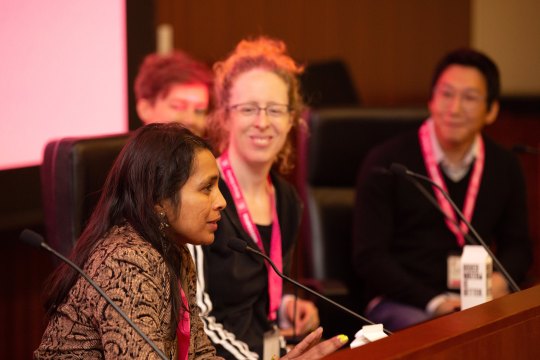Business of Art | Five Ways to Stake Your Claim in the Arts Ecosystem
Takeaways from the inaugural Art World Conference that can help you focus your creative energies to develop a more purposeful practice.
Art World Conference is a new business and financial literacy conference that includes panel discussions, conversations, and in-depth workshops addressing many of the opportunities and challenges faced by artists and arts professionals. The inaugural conference was held on April 25-27 in Manhattan, and brought 300 people together in dialogue around such topics as storytelling, marketing, investing, and growing and sustaining community. Fiscally Sponsored by The New York Foundation for the Arts (NYFA), the conference featured an esteemed line-up of speakers, moderators, and panelists including NYFA Board Member Tiana Webb Evans, Caroline Woolard (ABI ‘17), and Doctor’s Hours Consultants Larry Ossei-Mensah and Steven Sergiovanni. Here are five takeaways from the conference that you can apply to your practice today.
Tell Your Story
You know your work inside and out, and how you talk and write about it matters. Don’t rely on art world jargon to tell your story for you, it often distracts and can unintentionally distance people from your work. Says Writer and Critic Antwaun Sargent: “Sometimes language hides what you’re really after, and what you’re trying to say. Jargon can hinder the fullest expression of your work.“ He recommends that even artists who are uncomfortable writing write about their work. “It’s a good exercise, and it doesn’t need to be structured in a traditional way. Some of the best artists that I’ve come across have some sort of documentation of their work that is written [by them]. It allows for another expression” of their ideas. Curator Sara Raza frames it as a way of articulating the experience of the studio visit through writing: “Think about a set of words that aren’t overly theoretical but show key concerns of practice that articulate where you’re going and what you’re doing.”
Learn by Failing
As an artist, you’re constantly experimenting and problem-solving to achieve new heights in your career. The same mindset can be applied to other critical components of your career. “Insanity is defined as doing the same thing over and over again expecting different results,” said Mark Rosen, Associate Director of Marketing, Artsy. “It may be a blow to the ego, but you need to recognize what you’re doing and let it evolve,” he added. Rosen spoke specifically to how artists can find success on Instagram, a question that is on the mind of many creatives. One way to determine whether your posts and stories are resonating? First, use a free app like Planoly to plan out your posts in advance. This is an especially great benefit to artists with limited resources, as they can dedicate a block of time each week to schedule content in bulk. Timing is one of several factors that can help make your posts more or less successful, so test out times in two week increments and see what works best for your feed.
With social media and other components of your practice, re-evaluate regularly, as what may have worked for you in the past is no longer working in the present. “Social is changing every 15 seconds, it will change now and it will change again,” advises Rosen. In another panel discussion, Deborah Obaili, President and Executive Director, Association of Independent Colleges of Art & Design, cited the words of a colleague who encouraged artists to recognize that “what you need from a personal/creative practice standpoint is very different from the kinds of needs you’ll have in 20, 30, 40 years from now. There’s a continual learning curve.”
Resources: Emergent Strategy: Shaping Change, Changing Worlds (AK Press, 2017) and Atomic Habits: An Easy & Proven Way to Build Good Habits & Break Bad Ones (Avery, 2018)

Embrace Community
Community matters and can often open the door to new opportunities. Take the example of Prerana Reddy, Director of Programs, A Blade of Grass. She and a group of her peers formed the South Asian Women’s Artist Collective in 1997 to create a space for support and community and means of facilitating and presenting work. One of the members joined the staff of Queens Museum, brought Reddy into the fold, and helped to usher in a new era at the museum where it was more inclusive of its diverse local community. “Being accountable to the local community is not often something that a contemporary art museum does, but over time it became something that the Queens Museum did” and does through today.
Community also extends far beyond the walls of your studio, home, or office. “You’re part of a much larger ecosystem. Part of being in a creative practice is that you have a solid foundation from which to leap from,” said Esther Robinson, Co Executive Director, ArtBuilt, while moderating a discussion on real estate for visual artists. The panel stressed the importance of artists getting involved in their communities and holding state and local government accountable in the fight for affordable live and work space. Said Robinson: Developers “want us to give up. Make sure you know what your own values are and how to move forward.”
Wherever you make connections and foster community, do so authentically. Online, “Genuinely engage with content to help develop relationships. The more love you show, the more love you’ll get,” says Mark Rosen.
Resources: NYC Loft Tenants; Spaceworks; ArtBuilt; Never Eat Alone, Expanded and Updated: And Other Secrets to Success, One Relationship at a Time (Penguin Random House, 2014)
Practice Self-Care
Those in the arts community have a lot to juggle, from keeping up with the day-to-day to the larger pressures of defining success in a challenging industry. Lisa Kim, Director, The Ford Foundation Gallery, got to the heart of it by asking the question, “How can you manage your time and emotional resources wisely?” Alex Paik, Artist and Director, Tiger Strikes Asteroid, takes a refreshing approach: “Once you give up the idea that you can balance everything—just do what you are doing as well as you can while you’re doing it…Being present in the tasks that you’re doing makes them feel a bit more manageable.” Another piece of advice that can be applied widely comes from Prerana Reddy: “Find your time to be alone and whatever it is that’s meditative. You need to be bored to be creative. You need to pass boredom to get to creativity. It’s harder to get there because we don’t give ourselves time to be alone. Find that thing that allows you to be bored enough to rest yourself.”
Protect Your Work
“There’s no art market without the artists,” said Artist Mickalene Thomas in an afternoon panel discussion on Protecting Artists’ Rights that reviewed topics including contracts, copyright, and Fair Use. As artists, you have the power to control your narrative and legacy and you don’t have to do it alone. Artists’ Rights Society (ARS) represents the intellectual property rights of more than 80,000 artists and estates worldwide, including Thomas; it’s free and any artist can join. Pro-tip from Thomas: “When you have one blanket contract, it becomes easier to negotiate the others. Just have a clear understanding of what you want from the project, and write those down. If you do have a lawyer, try to go through it yourself first. When it comes time for the lawyer, it’s more for approval.” Said Attorney Anibal A. Luque: “A template is a great way to start protecting and enforcing your rights. Docracy.com is a great resource for usually artist-friendly templates. Another resource is UpConsel. Most contracts are governed state by state, so if you are getting a template make sure it is state specific.”
Additional Resources: Copyright Alliance, copyright.gov, Volunteer Lawyers for the Arts, A Fair(y) Use Tale, Legal Guide for the Visual Artist (Allworth Press, 2010), and nyfa.org.
Telling your story, learning by failing, embracing community, practicing self-care, and protecting your work are just a few of the ways that you can take a more active role in your arts career to initiate positive change and momentum. “There is no prescribed path, and even if there was it wouldn’t hold everyone in this room” said Deana Haggag, President/CEO, United States Artists during her keynote address at the Art World Conference. “Learning together and showing up for one another as needed is the only way to empower our field,” she added.
– Amy Aronoff, Senior Communications Officer
You can find more articles on arts career topics by visiting the Business of Art section of NYFA’s website. Sign up for NYFA News and receive artist resources and upcoming events straight to your inbox.
Have an arts career question? You can contact NYFA staff directly via the NYFA Source Hotline at (800) 232-2789, from Monday – Friday, 3:00 PM – 5:00 PM EST or email [email protected].
Are you an artist or a new organization interested in expanding your fundraising capacity through NYFA Fiscal Sponsorship? We accept out-of-cycle reviews year-round. No-fee applications are accepted on a quarterly basis, and our next deadline is June 30. Click here to learn more about the program and to apply.
Images: Antwaun Sargent, JiaJia Fei, Sara Raza, and Tiana Webb Evans during the “Defining Your Business: Storytelling” panel discussion and Prerana Reddy, Paddy Johnson, Caroline Woolard, and Alex Paik during the “You As Gatekeeper: Defining Goals and Initiating Opportunities” panel discussion, both at Art World Conference, Image Credit: Art World Conference and Alexa Hoyer.





